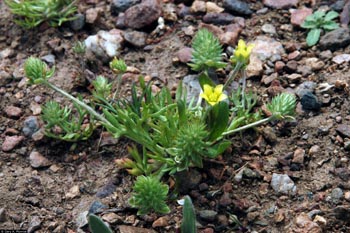Bur Buttercup

Common Name(s):
Bur Buttercup
Curveseed Butterwort
Scientific Name:
Ceratocephala testiculata (Crantz.) Bess.
Scientific Name Synonyms:
Ranunculus testiculatus Crantz.
Ceratocephala falcata auct. non (L.) Pers.
Ceratocephala orthoceras DC
Ranunculus falcatus auct. non L.
Symbol:
CETE5
Description:
Life Span: Annual
Origin: Introduced
Growth Characteristics: Bur buttercup is a winter annual that emerges, flowers, and sets fruits in the spring, when temperatures climb into the 45-50 degree range. Plants only grow to be 2 or 3 inches tall. They often occur in dense mats which cover large areas of the ground.
Flowers: Each blossom usually has 5 bright yellow petals. The flowers are very tiny, measuring less than a quarter inch long.
Fruits/Seeds: At maturity, each blossom develops into a bur, which dries and turns brown. ½ - ¾ inch long.
Leaves: Divided into finger-like segments, resembling a bird’s foot, and covered with fine hairs.
Stems: Short, leafless
Ecological Adaptions:
Bur buttercup has become widespread in gardens, small grains, pastures, waste areas, and along roadsides.
Soils: Widespread
Uses and Management:
This plant contains ranunculin, which changes into a highly toxic compound, protoanemonin, when the plant is crushed. Sheep have been poisoned and have died in the western United States after ingesting aboveground plant material. This plant is considered highly toxic. Signs of poisoning include anorexia, labored breathing, diarrhea, dyspnea, recumbency, weakness, and death.
It is important to control bur buttercup stands before they produce flowers and seeds. Hoeing, pulling, and digging can control it, or it can be sprayed with 2,4-D, Ally, Banvel + 2,4-D, Finale, Liberty, or Roundup. Burning is also a good form of control, if your area permits.

